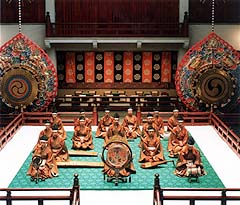From what you've said, I'll try expressing new ideas. Let us go back to the beginning, and reconstruct the UB from the start.
Kabuki is a relatively young classical art form in Japan, having been invented in the early 1600s. Much later than most classically Japanese arts, which often trace their origins back to the Heian period (9th to 12th centuries)
Hence the fact it is an Opera House replacement.
It started as a commoners, low-born art form, and all roles were played by women. The actors and dancers were all prostitutes who patrons could pay to have sex with after the show. When kabuki expanded to allow more different kinds of actors, it first let in young boys. That's right. So you could have sex with little boys.
Being a low-born art form which sometimes entered in conflict with the authorities (most notably for questions of morality), I think that one of the bonus of the UB should be a reduced upkeep cost (maybe only -1 GPT) : the people working in Kabuki depended mostly on their own ingenuity, skill and contacts to stay relevant in the artistic world.
NB : In one book I have on the history of Japanese society (big big book), it is stated that, after being involved in prostitution scandals, the Kabuki actresses have been replaced by young men. After similar scandals happened involving these young men, only older men became allowed to play Kabuki, and this had been like this ever since.
Many of the innovations in set design and costuming that are used today actually started in Japanese Kabuki, including wheeled, rotating stages, actors costumes that were rigged with wires so they could fly over the crowd, and liberal uses of trapdoors in the stage
As a "low" art, Kabuki was incredibly amenable to modernization and the influx of changes in the Meiji restoration. It rapidly changed and took in new ideas and themes, remaining relevant through much cultural upheaval and catapulting it into preeminence as an art form
So the Kabuki was a place of cultural and minor technical innovations which has successfully adapted to the many changes brought by the last centuries. Maybe additionnal bonus could be added when some Industrial/Modern/Atomic techs are researched, so that the building "stays relevant" ?
Worldwide, Kabuki is recognized because of its outlandish costumes and posturing. This has led to international interest, and Japanese kabuki theaters are often fitted with headphones for english translations of the dramas. Kabuki troupes have even recently gone through multiple tours of Asia, popularizing and increasing the art forms visibility in the region.
So one of bonus in the later eras could be a tourism bonus maybe ?
So there's very little in this which lends itself to anything outside tourism and culture. Science would be an awkward fit, and while faith is sort of relevant with the historical slant of some plays, it's tangential at best. The one other possibility I can think of is leaning into the "populist" side of kabuki, and having the building help with happiness. I hate this idea because it would inevitably take the form of a % modifier to poverty/boredom/etc., which is a black box of non-interactive... whatever.
For the "populist" side of the building, I think the reduced upkeep cost would be sufficient.
For the other yields :
-

Gold : The reduced upkeep is enough of a gold bonus I think
-

Food : It would have nothing to do with the building
-

Culture : The base building, and Japanese UCs in general, already give a lot of culture.
-

Faith : I don't think it would be a bad idea to add a faith bonus to the building, since the bonus Japan has in that domain are only relevant in the early game, and so a new faith boost wouldn't be redundant (it would mostly allow Japan to obtain more GP in the Industrial era).
-

GA points : Aside the fact that Japan has a lot of culture thanks to its UA/UB1, GAges don't synergize with this civ more than it synergizes with France or China.
-

GP points : Japan already has its UA to provide cultural GP throughout the game
-

Production : The only link between Kabuki and production would be the ingeniosity of the artists (I think a lowered cost would be good). That aside, the bonus science in the Dojo is also quite hard to explain, and it could be a reference to how Japan entered an era of urbanization and economic development in the Edo period.
-

Science : The Dojo already gives a small amount of science througthout the game, but Japan, a nation of rapide advancement since the Meiji era, lacks a real science bonus in the Industrial era, so adding some kind of scientific bonus during this era could be interesting.
-

Tourism : You know my point of view on this. I agree with tourism yield, but not in the Renaissance era.
I don't think it's too bad for OP'ness to give tourism to specialists, because there is a hard cap on its scaleability, it's a fairly late UB, and generating the max 36

other buildings, while relatively simple to do, still requires 9 other buildings and 18 population tied down in specialists. I think it's a relatively tame building in comparison to some existing ones, including the Dojo.
I agree that 38 tourism isn't a lot during the end of the Industrial era or the Modern era, but it is very significant in the Renaissance era, especially for a civilization which already has tools to have more tourism than the medium civilization.
As I already said above, if we add direct tourism to the UB, I would be for a bonus which comes in later eras.
Overall, Japan's more culturally oriented than militarilly, yet their UB leans HARD military. I think having UB with tourism flavor fits well enough into their kit, and has a role to play in their overall strategy.
I agree that tourism flavor could be good, but not in the Renaissance era, where there are already ways to have a lot of tourism through GW/religious beliefs/Artistry. Other civilizations with a tourism flavor in the early game suffers from the fact the yields per city are minor, and so going wide is required to have a lot of tourism (which isn't efficient since, as we know, obtaining new cities decreases the tourism output of the civilization, at least until late Artistry policies come into play), but Japan could obtain a substantial amount of tourism while also having a limited number of cities (since you can obtain the 36 tourism with only 3 cities).
So, what comes from all of this ?
If we follow only what Kabuki is and has been since its conception, the number of bonus is quite limited. However, I think we could take this building as a symbol of Japanese history from the 17th century to the present in order to add some interesting yields (it wouldn't be the first time a UB doesn't have yields corresponding exactly to its historical importance). Because of this, here is what I suggest :
- Reduced upkeep

cost
- Reduced production

cost
- Small increase of the yields

of the base building
- Increasing bonus to specialists through the eras (through the use of dummy buildings)
=> a tourism

bonus during the Modern/Atomic era (maybe to specialists, as seen below)
=> a scientific/production/faith

/

/

bonus to cultural specialists beginning the Industrial era
If we want to associate these bonus to cultural specialist, here is what I suggest :
- science

for writer specialists beginning the Industrial era
- production

for artist specialists beginning the Industrial era
- faith

for musician specialists beginning the Industrial era
- tourism

for all cultural specialists beginning the Modern era


 tourism?
tourism? for artist/writer/musician
for artist/writer/musician Food : It would have nothing to do with the building
Food : It would have nothing to do with the building Culture : The base building, and Japanese UCs in general, already give a lot of culture.
Culture : The base building, and Japanese UCs in general, already give a lot of culture. Faith : I don't think it would be a bad idea to add a faith bonus to the building, since the bonus Japan has in that domain are only relevant in the early game, and so a new faith boost wouldn't be redundant (it would mostly allow Japan to obtain more GP in the Industrial era).
Faith : I don't think it would be a bad idea to add a faith bonus to the building, since the bonus Japan has in that domain are only relevant in the early game, and so a new faith boost wouldn't be redundant (it would mostly allow Japan to obtain more GP in the Industrial era). GA points : Aside the fact that Japan has a lot of culture thanks to its UA/UB1, GAges don't synergize with this civ more than it synergizes with France or China.
GA points : Aside the fact that Japan has a lot of culture thanks to its UA/UB1, GAges don't synergize with this civ more than it synergizes with France or China. GP points : Japan already has its UA to provide cultural GP throughout the game
GP points : Japan already has its UA to provide cultural GP throughout the game Production : The only link between Kabuki and production would be the ingeniosity of the artists (I think a lowered cost would be good). That aside, the bonus science in the Dojo is also quite hard to explain, and it could be a reference to how Japan entered an era of urbanization and economic development in the Edo period.
Production : The only link between Kabuki and production would be the ingeniosity of the artists (I think a lowered cost would be good). That aside, the bonus science in the Dojo is also quite hard to explain, and it could be a reference to how Japan entered an era of urbanization and economic development in the Edo period. Science : The Dojo already gives a small amount of science througthout the game, but Japan, a nation of rapide advancement since the Meiji era, lacks a real science bonus in the Industrial era, so adding some kind of scientific bonus during this era could be interesting.
Science : The Dojo already gives a small amount of science througthout the game, but Japan, a nation of rapide advancement since the Meiji era, lacks a real science bonus in the Industrial era, so adding some kind of scientific bonus during this era could be interesting.

 specialists instead of the base 2
specialists instead of the base 2 Religious Unrest in city
Religious Unrest in city City connections in empire provide +1
City connections in empire provide +1 
 ), and I'm sure there would be a lot of balancing to do, but this will provide each Japanese guild its own uniqueness, without giving Japan much more cultural GP (it will already have a lot of them).
), and I'm sure there would be a lot of balancing to do, but this will provide each Japanese guild its own uniqueness, without giving Japan much more cultural GP (it will already have a lot of them).